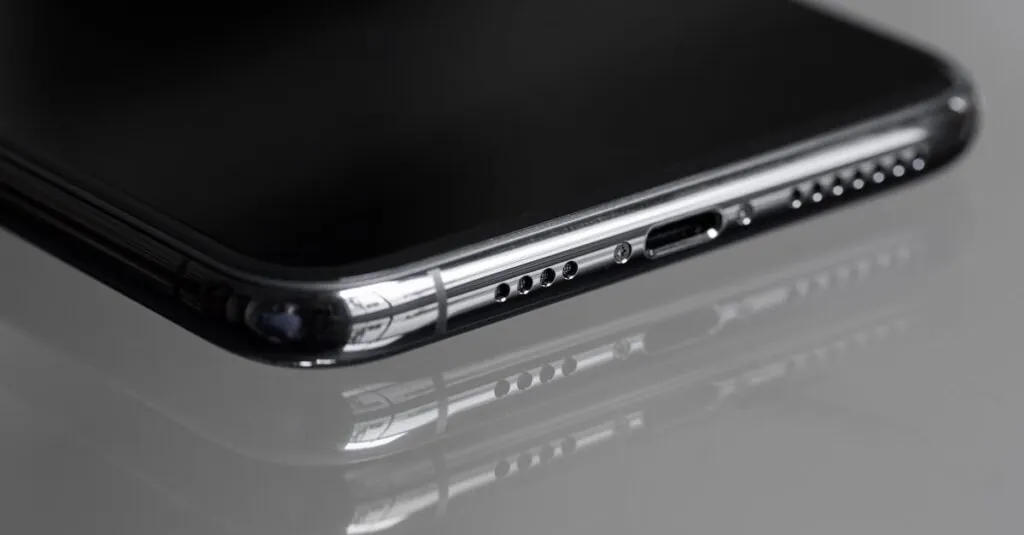Table of Contents
ToggleImagine a world where you can charge your phone without wrestling with tangled cords or searching for that elusive charging port. Sounds dreamy, right? Well, Apple made that fantasy a reality with the introduction of wireless charging on the iPhone. But when exactly did this magical moment happen?
In 2017, with the launch of the iPhone 8 and iPhone X, Apple finally embraced the future. They ditched the cords and brought us the convenience of wireless charging. It was a game-changer, allowing users to power up their devices with just a simple placement on a charging pad. So let’s dive into the journey of how iPhones went from being tethered to the wall to floating freely in the realm of wireless charging.
Overview of Wireless Charging Technology
Wireless charging technology utilizes electromagnetic fields to transfer energy from a charging pad to a device. This method eliminates the need for physical connectors and reduces wear on charging ports. Many devices, including smartphones and wearables, benefit from this technology, enhancing user convenience.
The key to wireless charging lies in induction. An inductive charging coil in the charging pad generates a magnetic field. The coil within the device then captures this field, transforming it into electrical energy. This process allows smartphones to charge simply by placing them on compatible pads.
Several standards govern wireless charging, with Qi being the most widely adopted. Qi certification ensures compatibility among various devices and chargers. Apple’s implementation of Qi technology marked a significant milestone in its product offerings, promoting universal access to wireless charging.
Efficiency varies across devices and charging pads. Most wireless chargers deliver power at rates between 5W and 15W. Some high-performance options can reach 30W or more, depending on manufacturer specifications. Such advancements allow faster charging times while maintaining the convenience of a cable-free experience.
Safety features play a crucial role in wireless charging technology. Overheating, foreign object detection, and automatic power adjustment prevent damage during charging sessions. These safeguards enhance user confidence while using wireless chargers.
Continued advancements in wireless charging promise a seamless experience. Future iterations may include longer ranges or alternative energy sources, further integrating this technology into everyday life. The evolution of wireless charging technology represents a notable stride toward a more efficient and user-friendly approach in powering devices.
Evolution of iPhone Models with Wireless Charging
Apple’s introduction of wireless charging began a new era for the iPhone lineup. The iPhone 8 and iPhone X marked the first models to embrace this technology in 2017.
iPhone 8 and iPhone X
The iPhone 8 and iPhone X showcased wireless charging with the Qi standard. Users could place the devices on charging pads for effortless power. These models supported 7.5W charging speeds, enhancing the charging experience. Integration of the glass back enabled efficient energy transfer while maintaining sleek designs. As a result, this shift contributed to the overall user convenience and set the stage for future innovations.
Subsequent Models Supporting Wireless Charging
Following the iPhone 8 and iPhone X, subsequent models continued to incorporate wireless charging. The iPhone XS, iPhone 11, iPhone 12, and iPhone 13 also featured the Qi standard, ensuring compatibility with existing chargers. Each model introduced improvements, such as magnetic alignment in the iPhone 12 series with MagSafe technology. Charging speeds increased as well, with some devices supporting fast charging up to 15W. This evolution reflects Apple’s ongoing commitment to enhancing user experience with reliable, efficient charging solutions.
Impact of Wireless Charging on User Experience
Wireless charging revolutionized how users interact with their devices. Convenience became a key feature, allowing individuals to simply place their iPhones on a charging pad. Physical cables are no longer necessary, which reduces wear and tear on charging ports.
User trust in the technology increased due to enhanced safety features. Overheating protection and foreign object detection prevent common charging issues. Compatibility with the Qi standard also means that users can access a variety of charging options, further increasing convenience.
Charging speeds evolved significantly since the introduction of wireless technology. Initial models like the iPhone 8 and iPhone X supported 7.5W, but later releases boosted this to 15W with MagSafe technology. Users experience faster charging times alongside the wireless feature, improving overall satisfaction.
Design plays a crucial role in enhancing user experience. The glass back of newer iPhone models facilitates efficient energy transfer while maintaining aesthetic appeal. Sleek designs ensure that functionality and style coexist, attracting users who value both.
Efficiency remains a priority as advancements in wireless charging continue. Future improvements promise longer ranges and alternative energy sources, further streamlining the charging process. Users benefit from these innovations as they seek more seamless and reliable ways to power their devices.
The integration of wireless charging marked a significant shift in user habits. A growing number of charging stations are available in public spaces, making it easier for users to stay powered up while on the go. The impact of this technology on daily routines highlights its importance in modern smartphone usage.
Comparison with Other Smartphone Brands
Wireless charging adoption varies among smartphone brands. Apple’s introduction of this technology in 2017 with the iPhone 8 and iPhone X set the stage for its broader acceptance. Competitors like Samsung embraced wireless charging, releasing models such as the Galaxy S6 in 2015, which also utilized the Qi standard.
Charging speeds differ across brands. Most Android devices typically support charging rates between 10W and 15W, with some like the Galaxy S21 supporting up to 25W. In contrast, newer iPhones, starting from models like the iPhone 12, reached charging speeds of 15W through MagSafe, enhancing efficiency.
Safety features remain crucial in the smartphone market. Devices from various manufacturers incorporate overheating protection and foreign object detection, yet Apple’s emphasis on these features has garnered user confidence. Brands such as Google focus on usability, ensuring compatible accessories enhance user experience.
Design choices affect wireless charging capabilities. Many flagship models from Android brands utilize glass backs similar to iPhone designs, promoting effective energy transfer. Apple’s MagSafe technology introduced magnetic alignment, optimizing charging experience by positioning devices accurately.
Market availability of charging solutions also plays a role. Numerous manufacturers participate in the Qi ecosystem, providing a range of compatible accessories. Public spaces are increasingly featuring charging stations, making wireless charging more accessible for all users.
Overall, Apple’s approach to wireless charging reflects its commitment to innovation and user experience. Other smartphone brands continue to evolve, contributing to a growing industry-wide trend toward wireless solutions.
Future of Wireless Charging in Smartphones
Advancements in wireless charging technology promise to reshape the smartphone landscape. Longer ranges might soon allow users to charge devices without needing them in direct contact with charging pads. Innovations like resonant induction could enhance charging efficiency further, leading to faster power delivery.
Many manufacturers are exploring alternative energy sources to integrate into wireless systems. Solar charging, for instance, could provide an eco-friendly option for powering devices on the go. The ongoing development of energy harvesting technologies highlights a shift toward more sustainable methods.
Apple’s focus on wireless charging includes plans to expand its MagSafe ecosystem. This technology optimizes the alignment of devices with chargers, ensuring efficient energy transfer. The integration of MagSafe into future iPhone models might continue to enhance user experience by simplifying the charging process.
Compatibility remains key in the wireless charging market. Industry leaders are likely to pursue universal standards similar to Qi to ensure seamless interoperability among devices. This would allow users to feel confident using various chargers without compatibility concerns.
Expectations indicate that future devices could integrate additional safety features. Innovations such as autonomous monitoring of charging environments may enhance user trust. These improvements could significantly reduce risks associated with overheating or foreign object interference.
Charging speeds are set to increase as new technologies emerge. Some prototypes already showcase capabilities beyond current industry standards. With potential charging speeds exceeding 30W, user convenience will significantly improve.
The future of wireless charging aligns with the growing trend of convenience in technology. As public charging stations continue to proliferate, users may find more opportunities to charge devices effortlessly. Preferences for wireless solutions reflect the demand for smarter, more efficient technology in daily life.
The introduction of wireless charging with the iPhone 8 and iPhone X marked a pivotal moment in smartphone technology. This shift not only enhanced user convenience but also set a new standard in the industry. As wireless charging continues to evolve with advancements like MagSafe and increased power delivery, users can expect even greater efficiency and safety in their charging experiences. The future holds exciting possibilities for wireless technology, promising to further integrate into everyday life and redefine how devices are powered. With a focus on compatibility and innovation, the journey of wireless charging in the iPhone ecosystem is just beginning.







